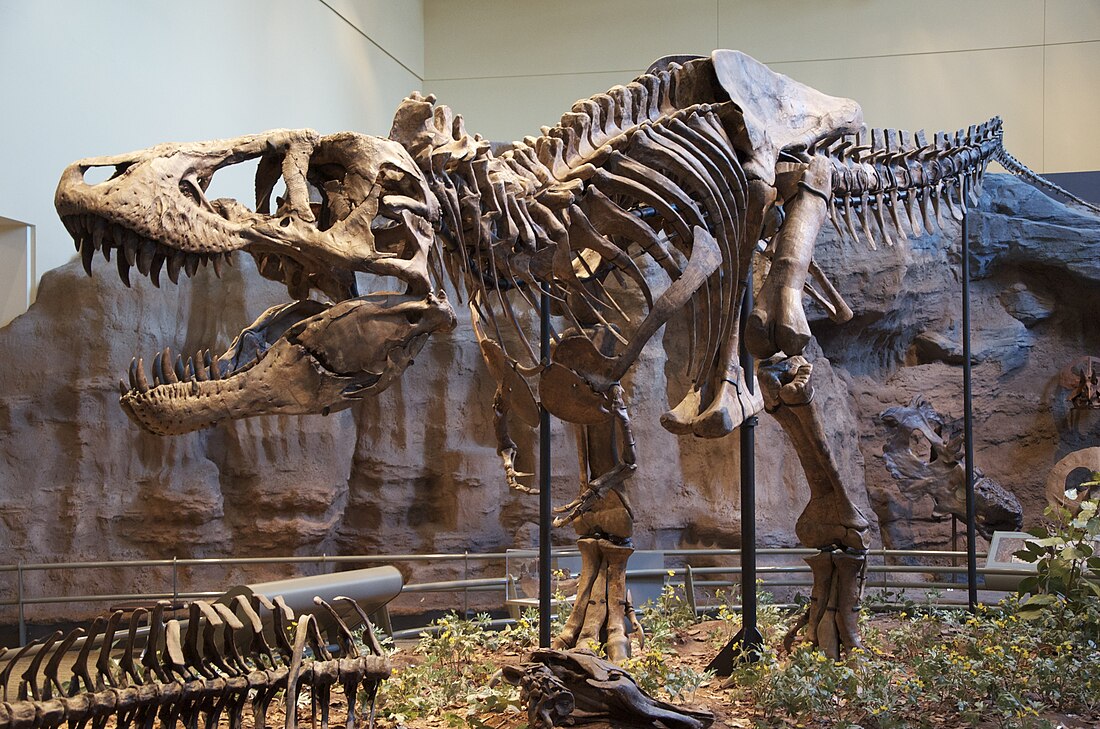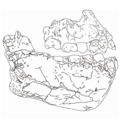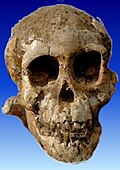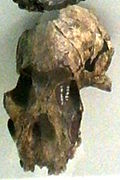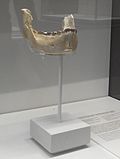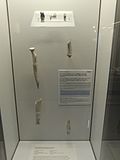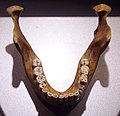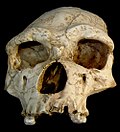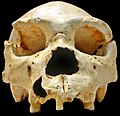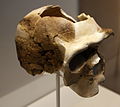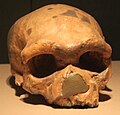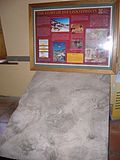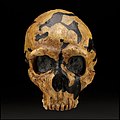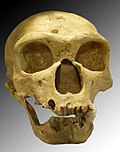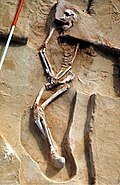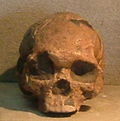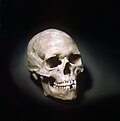Top Qs
Timeline
Chat
Perspective
List of human evolution fossils
From Wikipedia, the free encyclopedia
Remove ads
The following tables give an overview of notable finds of hominin fossils and remains relating to human evolution, beginning with the formation of the tribe Hominini (the divergence of the human and chimpanzee lineages) in the late Miocene, roughly 7 to 8 million years ago.
As there are thousands of fossils, mostly fragmentary, often consisting of single bones or isolated teeth with complete skulls and skeletons rare, this overview is not complete, but shows some of the most important findings. The fossils are arranged by approximate age as determined by radiometric dating and/or incremental dating and the species name represents current consensus; if there is no clear scientific consensus the other possible classifications are indicated.
The early fossils shown are not considered ancestors to Homo sapiens but are closely related to ancestors and are therefore important to the study of the lineage. After 1.5 million years ago (extinction of Paranthropus), all fossils shown are human (genus Homo). After 11,500 years ago (11.5 ka, beginning of the Holocene), all fossils shown are Homo sapiens (anatomically modern humans), illustrating recent divergence in the formation of modern human sub-populations.
Remove ads
Late Miocene (7.2–5.5 million years old)
Summarize
Perspective
Further information: Chimpanzee–human last common ancestor, Ardipithecus, Sahelanthropus, Homininae, and Hominini
The chimpanzee–human divergence likely took place around 10 to 7 million years ago.[1] The list of fossils begins with Sahelanthropus, dated some 7 million years ago, which may or may not be ancestral to both the human and the chimpanzee lineage, although its status as a hominin or a hominin ancestor remain debated. For the earlier history of the human lineage, see Timeline of human evolution#Hominidae, Hominidae#Phylogeny.
More information Image, Name ...
| Image | Name | Age (Ma) | Species | Year discovered |
Country | Discovered by | Now located at |
|---|---|---|---|---|---|---|---|
 |
TM 266 (Toumai) | 7.00–6.00[2] | Sahelanthropus tchadensis | 2001 | Chad Site:Djurab Desert |
Alain Beauvilain, Fanone Gongdibe, Mahamat Adoum and Ahounta Djimdoumalbaye | N'Djamena (Chad), BEAC |
 |
BAR 1000'00 | 6.1–5.7[3] | Orrorin tugenensis | 2000 | Kenya Site:Lukeino |
Martin Pickford, Kiptalam Cheboi, Dominique Gommery, Pierre Mein, Brigitte Senut | |
 |
ALA-VP 1/20[4] | 5.65±0.150 | Ardipithecus kadabba | 1997 | Ethiopia Site:Middle Awash |
Yohannes Haile-Selassie | |
Close
The Trachilos footprints from the island of Crete as well as the Graecopithecus fossils are not included in the list due to taxonomic uncertainty.
Remove ads
Pliocene (5.3–2.58 million years old)
More information Image, Name ...
Close
Remove ads
Pleistocene
Summarize
Perspective
Lower Paleolithic: 2.58–0.3 million years old
More information Name, Age (Ma) ...
Close
Middle Paleolithic: 300,000–50,000 years old
Further information: Middle Stone Age, Southern Dispersal, Archaic humans, and Anatomically modern humans
More information Name, Age (ka) ...
Close
Upper Paleolithic: 50,000–11,500 years old
Further information: Archaic humans, Anatomically modern humans, Archaic admixture, Recent human evolution, and Epipalaeolithic
Further information: European early modern humans § Assemblages and fossils
More information Name, Age (ka) ...
Close
Remove ads
Holocene (11,500–5,000 years old)
More information Name, Age (ka) ...
| Name | Age (ka) | Culture / association |
Year discovered |
Country | Discovered by | Now located at | |
|---|---|---|---|---|---|---|---|
 |
Luzia | 11.5[171] | Paleo-Indian | 1975 | Brazil | ||
| [172] | Cerro Sota 2[173] | 11 | 1936 | Chile | |||
| "Satsurblia" | 10 | Caucasian Epipaleolithic (CHG)[165] | Georgia | ||||
 |
Yaho skull[174] | 10? | 1961 | Chad | |||
 |
Kow Swamp 1 | 13–9 | 1968 | Australia | |||
 |
Talgai Skull[175] | 10±1 | 1886 | Australia | |||
 |
La Brea Woman | 10 (8000 BC) | Paleo-Indian | 1914 | United States | ||
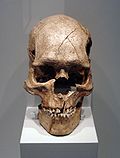 |
Combe Capelle | 9.6 (7600 BC)[176] | European Mesolithic | 1909 | France | ||
| Asselar man | Between 9500 BP and 7000 BP, with caution, 6390 BP[177] | Neolithic | 1927 | Mali | |||
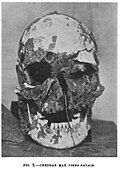 |
Cheddar Man | 9 (7000 BC) | British Mesolithic | 1903 | United Kingdom | Natural History Museum, London | |
 |
Kennewick Man | 9 (7000 BC) | Archaic period (North America) | 1996 | United States | ||
 |
Barum Woman | 8.8 (6800 BC) | European Mesolithic | 1939 | Sweden | ||
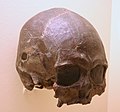 |
Tepexpan man | 8±3 | Paleo-Indian | 1947 | Mexico | ||
 |
Loschbour man[178] | 8 (6000 BC) | European Mesolithic (WHG) | 1935 | Luxembourg | ||
 |
Minnesota Woman | 7.9±0.1 (5900 BC) | Paleo-Indian | 1931 | Minnesota, United States | ||
| Lothagam 4b (Lo 4b)[179] | 7.5±1.5[180] | 1965–1975 | Kenya | ||||
 |
Bessé'[181] | 7.3–7.2 | Toalean | 2015 | Sulawesi, Indonesia | ||
 |
Ötzi | 5.3 (3230 BC) | European Neolithic | 1991 | Ötztal Alps, Italy | South Tyrol Museum of Archaeology, Bolzano, Italy | |
| Tarim mummies | 4.1 (2135 BC) | Afanasievo culture | 1970's | Tarim Basin, China |
Close
Remove ads
Abbreviations used in fossil catalog name
- AL – Afar Locality, Ethiopia
- ARA-VP – Aramis Vertebrate Paleontology, Ethiopia
- BAR – (Lukeino, Tugen Hills) Baringo District, Kenya
- BOU-VP – Bouri Vertebrate Paleontology, Ethiopia
- D – Dmanisi, Georgia
- ER – East (Lake) Rudolf, Kenya
- KGA – Konso-Gardula, Ethiopia
- KNM – Kenya National Museum
- KP – Kanapoi, Kenya
- LB – Liang Bua, Indonesia
- LH – Laetoli Hominid 4, Tanzania
- MH – Malapa Hominin, South Africa
- NG – Ngandong, Indonesia
- OH – Olduvai Hominid, Tanzania
- SK – Swartkrans, South Africa
- Sts, Stw – Sterkfontein, South Africa
- TM – Transvaal Museum, South Africa
- TM – Toros-Menalla, Chad
- WT – West (Lake) Turkana, Kenya
Remove ads
See also
References
Further reading
External links
Wikiwand - on
Seamless Wikipedia browsing. On steroids.
Remove ads
Remove ads
